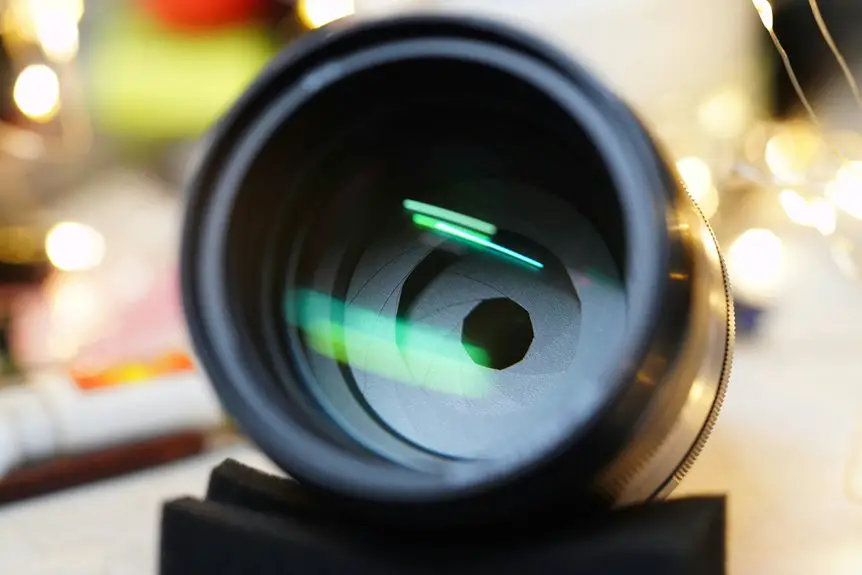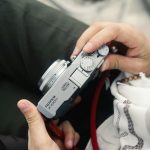To make your own photography scrim for perfect lighting, start with a lightweight frame like PVC pipes or collapsible tent poles. Choose a translucent fabric such as ripstop nylon or muslin to softly diffuse light without blocking it. Stretch the fabric taut over the frame using strong clips, ensuring even coverage. Place the scrim between your light source and subject to reduce harsh shadows. Keep it portable and handle with care for long-lasting use. If you want to explore versatile tips and uses, keep going.
Table of Contents
Key Takeaways
- Use lightweight frame materials like PVC pipes or collapsible tent poles for easy handling and portability.
- Choose translucent fabrics such as ripstop nylon or muslin to diffuse light without blocking it completely.
- Secure fabric tightly to the frame using strong clips or clamps to ensure smooth, even diffusion.
- Position the scrim between the light source and subject, adjusting distance and angle for optimal soft lighting.
- Store and maintain the scrim properly by avoiding heavy pressure and cleaning gently to prolong its lifespan.
Understanding the Purpose of a Photography Scrim
A photography scrim softens and controls light, helping you create more flattering images.
When you use a scrim, it diffuses harsh sunlight or artificial light, reducing strong shadows and glare that can ruin a shot. It acts like a filter, spreading light evenly across your subject, which highlights details and textures gently.
You’ll find scrims especially useful outdoors, where direct sunlight can be too intense. They also provide more control over lighting without needing expensive gear.
By managing the light intensity, you can achieve a natural, balanced look that enhances your photography’s overall quality.
Understanding how a scrim shapes light sets the foundation for making one yourself and elevating your photo sessions.
Materials Needed for a DIY Scrim
Gathering the right materials is essential to building an effective photography scrim that meets your needs.
You’ll need a lightweight frame—PVC pipes or collapsible tent poles work well. They’re sturdy yet easy to handle. For the diffusing surface, you’ll want a white fabric or translucent material, but we’ll discuss fabric choices next.
To hold your fabric taut, grab some strong clips or clamps. If you want portability, consider Velcro strips or elastic bands to attach the fabric securely.
You’ll also need basic tools like scissors, a measuring tape, and a marker for precision.
Finally, a carrying bag or case will keep your scrim protected and easy to transport.
With these materials ready, you’re set to build a scrim tailored to your lighting needs.
Choosing the Right Fabric for Diffusion
Once you have your frame and tools ready, selecting the right fabric for diffusion becomes the next step.
You’ll want a material that softens light without blocking it completely. Look for lightweight, translucent fabrics like ripstop nylon, muslin, or even white polyester. These options scatter light evenly, reducing harsh shadows and glare.
Choose lightweight, translucent fabrics like ripstop nylon or muslin to soften light and reduce harsh shadows.
Avoid thick or opaque fabrics—they’ll cut too much light and defeat your scrim’s purpose. Also, consider durability and portability; ripstop nylon is tear-resistant and packs easily, making it ideal for outdoor shoots.
Test a small piece by holding it in front of a light source to see how it diffuses. Choosing the right fabric guarantees your scrim delivers smooth, flattering light every time you shoot.
Selecting the Frame for Your Scrim
When selecting the frame for your scrim, consider materials like PVC, wood, or metal based on your budget and durability needs.
You’ll want a frame size that comfortably fits your chosen fabric while being easy to handle during shoots.
Keep in mind the balance between portability and coverage to get the best results.
Frame Material Options
Choosing the right frame material is essential for building a durable and effective photography scrim. You want something lightweight yet sturdy to handle frequent setup and breakdowns.
Aluminum tubing is a popular choice—it’s strong, rust-resistant, and easy to cut or drill. PVC pipes offer an affordable, lightweight alternative and are simple to assemble with connectors, but they might flex under tension.
Wooden dowels provide solid support and a natural feel, but they can be heavier and less portable. Consider your scrim’s size and how often you’ll use it when picking materials.
If you plan to travel with your scrim, prioritize lightweight options. Ultimately, select a frame material that balances strength, portability, and ease of assembly to create a scrim that suits your shooting needs perfectly.
Ideal Frame Dimensions
After picking the right frame material, you’ll want to focus on the ideal dimensions for your scrim frame.
Generally, a frame size between 24×24 inches and 36×48 inches works well for most photography needs. Choose a size that’s large enough to soften light effectively but still portable and easy to handle.
If you shoot portraits, a 36×48-inch frame offers ample coverage for flattering, diffused light. For product photography or smaller setups, a 24×24-inch frame might be perfect.
Remember to evaluate your typical shooting environment and gear—larger frames can block more light but may be cumbersome. Tailor your frame size to suit your style and workflow for the best results.
Step-by-Step Assembly Instructions
Since assembling your photography scrim requires careful attention, you’ll want to gather all materials and tools before you begin.
Start by cutting your PVC pipes to your desired frame dimensions. Connect the pipes using the PVC elbows to form a rectangular or square frame.
Next, stretch your diffusion fabric tightly over the frame, ensuring there are no wrinkles. Use clamps or strong tape to secure the fabric to the frame edges firmly.
Stretch diffusion fabric tightly over the frame, securing it with clamps or tape for smooth, wrinkle-free light diffusion.
Double-check that the fabric is evenly taut to avoid uneven light diffusion. Finally, attach handles or a stand mount if needed for easier positioning during shoots.
Your scrim is now assembled and ready to soften your light source effectively.
Tips for Using Your Scrim Effectively
To get the best soft light, position your scrim between the light source and your subject at the right distance.
Watch out for unwanted shadows and glare by adjusting angles carefully.
With practice, you’ll control your lighting like a pro.
Positioning for Soft Light
Where you place your scrim can make all the difference in achieving soft, flattering light. Position it close to your subject to diffuse harsh light, but adjust distance to control softness. Placing the scrim between the light source and subject creates even illumination. Experiment with angles to reduce hotspots without sacrificing brightness.
| Position | Effect | Tip |
|---|---|---|
| Close to subject | Maximum softness | Use for portraits |
| Far from subject | Subtle diffusion | Ideal for larger scenes |
| Directly in front | Even light spread | Avoid shadows on face |
| Angled slightly | Controlled highlights | Best for textured subjects |
Try moving your scrim around while observing the changes—this helps reveal the perfect setup for your shot.
Managing Shadows and Glare
Managing shadows and glare effectively can make or break your shot when using a scrim. To control shadows, adjust the scrim’s distance from your subject—closer softens shadows, while moving it back creates more defined ones.
Angle the scrim to diffuse harsh light evenly, preventing unwanted glare. If glare appears on reflective surfaces, try repositioning the scrim or changing your shooting angle.
Using multiple scrims or combining them with reflectors can help balance light and shadow for a natural look. Keep an eye on the light’s intensity, and don’t hesitate to tweak your setup mid-shoot.
Maintenance and Storage of Your DIY Scrim
Although your DIY scrim is designed for durability, regular care guarantees it performs well and lasts longer.
After each shoot, gently brush off any dust or debris with a soft cloth or a lint roller. If it gets stained, spot clean with mild soap and water—avoid harsh chemicals that could damage the fabric.
Once dry, fold your scrim neatly to prevent creases or wrinkles that might affect light diffusion. Store it in a cool, dry place away from direct sunlight to prevent fading and fabric weakening.
Avoid placing heavy objects on top of it, which could deform the frame or scrim material.
Taking these simple steps verifies your scrim stays in prime condition, ready to deliver perfect lighting whenever you need it.
Creative Uses Beyond Traditional Photography
Keeping your DIY scrim in excellent shape not only guarantees its longevity but also opens up a world of creative possibilities beyond standard photography.
You can use it as a soft, diffused light source for video shoots, improving shadows and highlights with minimal equipment. It also works great as a backdrop for product shots or small art projects, providing a clean, neutral surface.
If you enjoy painting or crafting, the scrim’s translucent fabric can serve as a light filter or shadow screen for unique effects. Additionally, it’s perfect for outdoor use, reducing harsh sunlight during portraits or nature photography.
Frequently Asked Questions
Can I Use a Photography Scrim Outdoors in Windy Conditions?
You can use a photography scrim outdoors in windy conditions, but you’ll need to secure it well with sturdy clamps and weights. Otherwise, the wind might make it unstable or damage your scrim, so always prepare accordingly.
How Do I Transport a Large DIY Scrim Safely?
You’ll want to fold your large DIY scrim carefully and store it in a sturdy, padded bag or tube. Use straps to secure it, and avoid sharp bends to keep the frame and material safe during transport.
What Are Common Mistakes to Avoid When Using a Scrim?
You’ll want to avoid uneven lighting, harsh shadows, and placing the scrim too close to your subject. Don’t forget to secure it properly to prevent movement, and avoid using dirty or wrinkled materials that affect light diffusion.
Can a Scrim Be Used With Flash and Natural Light Simultaneously?
Back in the days of the telegraph, you’d find that yes, you can use a scrim with flash and natural light simultaneously. Just position it right to balance harsh shadows, and you’ll get beautifully diffused lighting every time.
How Do I Repair Tears or Damage on My Scrim Fabric?
You can repair tears by carefully sewing them with a needle and thread matching your scrim fabric. For small holes, use fabric adhesive or patch on the backside to reinforce without affecting light diffusion.
- Does Chiffon Fabric Stink - July 15, 2025
- Does Chiffon Fabric Affect the Economy - July 15, 2025
- Does Cotton Fabric Have a Nap - July 15, 2025







